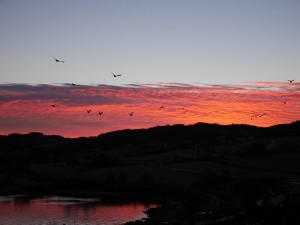The only reason this is possible at all is that it has been so dry this autumn!
I’ve lost my long crow bar, otherwise I would have used that..
Jackdaws (kaie) fly every morning to breakfast which is served in the fields to the east of here…standing on my bedroom balcony, there’s suddenly a pressure wave as a small group of birds fly at breakneck speed right over the roof above my head…must try to film it one day…but this morning they and I also had a glorious view too…dreaming of coming back as a jackdaw…they have so much fun it seems!
After Ariane Burgess had showed me round the Edible Woodland Garden, I’d been invited to lunch by Craig Gibsone, one of the elders of Findhorn having been involved with the Findhorn Foundation for well over 40 years! He had also been at my talk the night before at the Tiny Weeny Farm, and he seemed familiar as I’d seen a Youtube interview with him (see the link above) some time ago! Craig was born in Australia but considers Findhorn to be his spiritual home. He is a multi-talented teacher, potter, painter, musician, gardener and permaculturist….and it was a real pleasure too to be in his company for a couple of hours! For more, see the picture gallery below!
When I visited Japan in early spring 2016, I noticed a violet/purple flower growing as an ornamental in some gardens and also escaped as a weed.
I finally realized that it was a plant I had grown for a couple of years (2011-2012) as an unusual annual vegetable, Orychophragmus violaceus, known as ‘Chinese Violet Cress’ or ‘February Orchid’, sourced from Horizon Herbs in the US. Despite one of its common names, it’s not an orchid but is related to cress, belonging to the cabbage family Brassicaceae.
It hadn’t grown particularly well in my garden, but it did manage to flower and I used them in various salads during those two years, adding a different colour to the mix and it continued flowering right to the first frosts in November! It was also badly attacked by the usual pests of Brassicas, but it bounced back with masses of shoots from the roots in the autumn when the pest pressure was released. It doesn’t like temperatures below -5C and therefore didn’t have much chance of overwintering here in Malvik (it is biannual in the Far East).
Orychophragmus violaceus has a wild distribution in China and Korea and was introduced to Japan a long time ago both as an ornamental and also as a potential oil seed crop (you can google pictures of it growing alongside rape oil plants). In the wild it has a wide range of habitats from woodlands, gardens, roadsides and open fields. In Japan it has widely naturalized in many habitats thanks to its adaptability and it is now found throughout the islands, encouraged by gardeners who love the early spring flowers. In some parts it carpets woodlands in the early spring and it has been described as the Bluebell of Japan! However it is also a weed in gardens (and as such one of the world’s most beautiful weeds!). In Japan it is known as hanadaikon (“flower-daikon”), which name is also used for Hesperis matrionalis (dame’s violet), ooaraseitou, murasaki-hana-na (“purple-flower-rape”), shikinsou (“purple-gold-plant”). Shokatsusai / zhu ge cai is its Chinese name.
It has also been used as a forage species in China:
“Its shoots are rich in protein, iron, calcium and vitamins A and C. Hence it is a valuable forage. Its shoot yield is high, about 36,400 kg/ha, when cultivated in Chengdu. This plant species is adaptable to grassland, barren hills, roadsides, gardens, etc. Its protein content is higher than most other forage plants.”
Orychophragmus violaceus is mentioned as an edible wild plant alongside Udo (Aralia cordata) in Joy Larkcom’s Oriental Vegetables!
Here’s an album of my own pictures from our visit to Tokyo’s underground Udo forcing holes…
More about Udo (Aralia cordata) on my web site www.edimentals.com
Thanks again to Ken Minatoya-Yasuda for liaising with the agriculture industry Tourism Division in Tachikawa city!! We were the first Europeans to ask for this particular tour!! Thanks also to Tei Kobayashi for acting as interpreter and great to meet local gardening blogger Joan Lambert Bailey and friends on the day!! We all had a great day I think!!
Please help translating the text on some of the pictures!
Other Udo posts on this blog:
http://www.edimentals.com/blog/?p=8284 (Udo cavern video and Tei’s pictures)
http://www.edimentals.com/blog/?p=7499 (My “The Many Uses of Udo” Permaculture Magazine article and pictures taken by Naturplanteskolen who joined me on the trip!
To see an underground Udo (Aralia cordata) farm has long been a dream. My dream was finally fulfilled this spring and below you can see a short video I took in the Udo cavern! I’ve also added 3 videos above the ground where you can see piles of spent Udo roots…the roots themselves have been used medicinally, but at the moment are going to waste :(
Below the videos is a gallery of photos taken by my friend Tei Kobayashi who acted as interpreter!
More pictures from the visit can be seen here: http://www.edimentals.com/blog/?p=7499
Thanks to my friend Tei Kobayashi for the following pictures taken during our visit to the underground udo farm in Tokyo.
The last 3 days, I’ve been harvesting as quickly as I can as it’s very cold for the time of year (max. about -6C today) and the earth is now frozen to 5-6 cm deep….at this rate it won’t be possible to break up the surface layer with hand tools…but a few things like leeks will have to wait until the weekend….hoping I can get them up…
A short video of the wonderful Taunton Deane perennial kale at Knighthayes Court in Devon, UK where I visited on May 13th 2016.
See more pictures here: http://www.edimentals.com/pictures/index.php?/category/112
Other pages about Knightshayes:
http://www.edimentals.com/blog/?page_id=2505
Taunton Deane’s Perennial Kale at Knightshayes in 2011: http://www.edimentals.com/blog/?page_id=1147